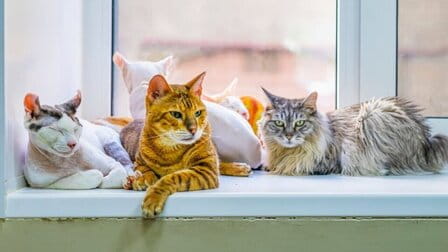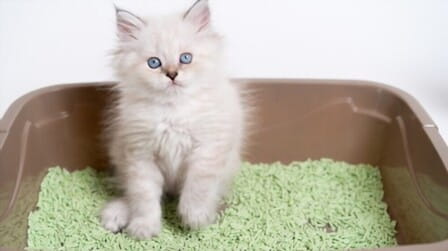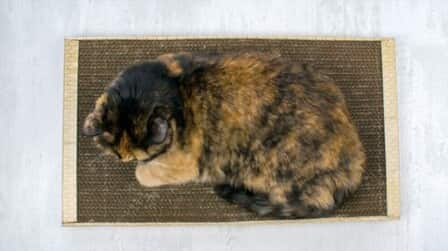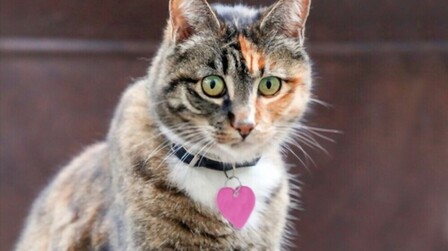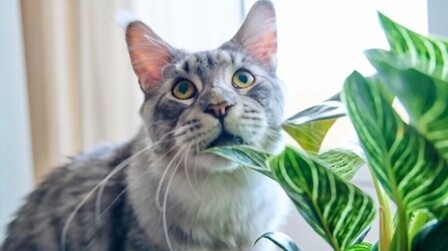In daily life, there are two things we love, that is: plants and pets. Nowadays, there are many families with pets (dogs and cats) in the house, this is their pet. And in the home space, it's not too difficult to come across houseplants.
However, dogs and cats can even nibble on houseplants, attacking the waving leaves like a toy. It's hard to keep house plants from a pet determined to chew. Many common plants are not safe for dogs and cats. Certain plants will be toxic to pets when ingested, they might cause seizures, tremors, or worse.
There are some plants that can be toxic to dogs and cats when ingested, dangerously can lead to convulsions, tremors, worse than death. So we must make sure that any plants we grow indoors are safe and non-toxic for dogs and cats.
It's great to add plants to your home to clean the air and improve your mood, but you also need to make sure your furry friend is safe and healthy.
Below, we also provide information on some suitable, safe houseplants for cats and dogs.
1. Rattlesnake Plant
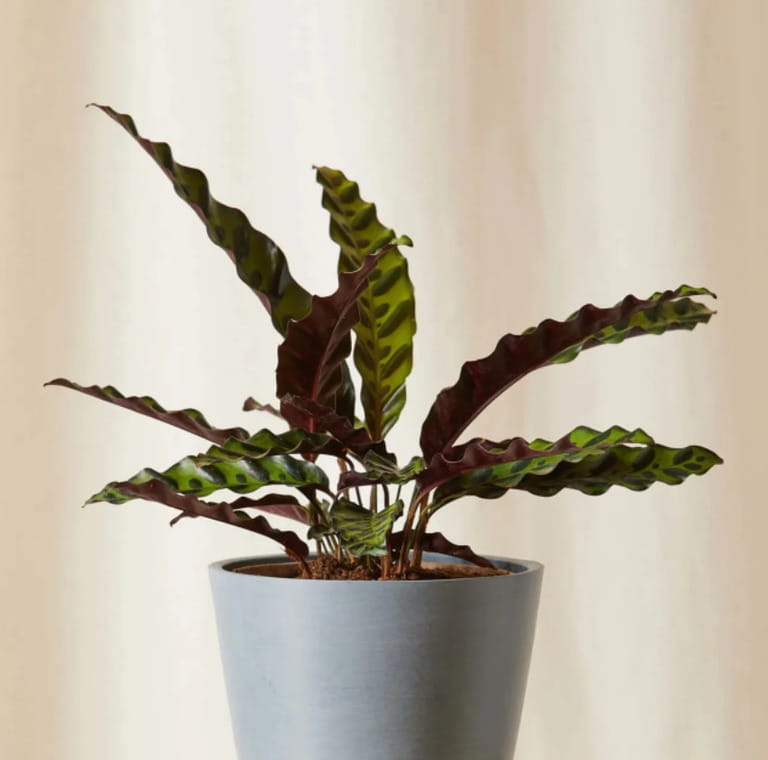
This plant has purple leaves. The color and leaves of this plant have a different shape than some other houseplants, easy to care for. It makes a great addition to a dimly lit living room.
The rattlesnake plant grows best in loose, fast-draining soil. You should fertilize them monthly to ensure they grow well. These plants thrive when placed out of direct light, in the ideal temperature range of 70–80 degrees F. When the top of the soil feels dry to the touch, you need extra watering. Their dry leaves look fancy, but better ensure enough water for the plant.
2. Spider Plant

A favorite with veterinarians, this plant is easy to grow indoors and is exceptionally resilient, even for those with no experience with plant care. Not only beautify but it also green your space. It is a great air purifier, so they can help remove toxins from your home.
Note for the spider plant, it does not like direct sunlight (leaving it in direct sunlight will burn their leaves). Although they will tolerate lower light conditions, indirect light at 60–80 degrees F is where they thrive best.
3. Parlor Palm
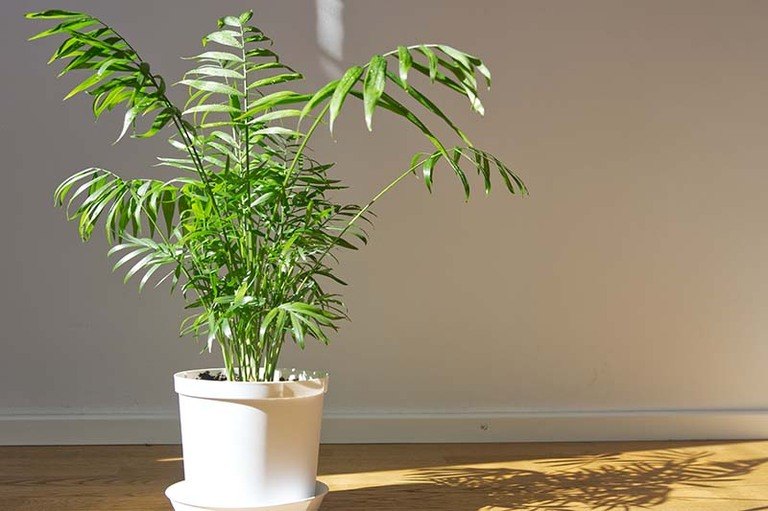
This plant is coniferous, with long and small leaves. Since this plant only needs indirect light for a few hours a day, keep it on a nightstand not too close to a window. Keep the plant out of direct sunlight and keep the soil evenly moist for best results.
The Parlor palm tree is a naturally slow-growing tree that takes several years to reach 3 to 4 feet tall.
4. Calathea Orbifolia

The leaves of this Calathea Orbifolia are relatively large, oval in shape. This houseplant needs partial shade, which makes it ideal for growing plants or shelves in bedrooms that don't get a lot of natural light.
It is not suitable to be in the sun (sunlight can burn their leaves). The plant likes high humidity. Regular watering will ensure your plant stays healthy and hydrated, and keeps it in a room that's 60–80 degrees Fahrenheit. Consider misting it regularly or keeping it near a humidifier.
5. Ponytail Palm

The ponytail, aka Beaucarnea recvata, has so many traits your pet might want to befriend it because of its luxuriant leaves. Horsetail palms are the ideal plant of your choice: They only need to be fertilized two to three times a year. They require dry soil, so make sure not to over-water them.
6. (Certain) Succulents

This is a pet-friendly cactus.
With this popular cultivar, you won't have to worry about it too much, but you do need to make sure they get plenty of direct sunlight and water lightly every two weeks. Make sure the soil is dry before you remove the watering can.
7. African Violet

If you have open shelves in your kitchen, these flowers would be a colorful and wonderful addition. Eye-catching purple color attracts dogs and cats. Just make sure the plant isn't near a window or vent in the floor that gets a lot of drafts. It will bloom beautifully if you place them in indirect sunlight.
These flowers thrive in temperatures of 73–77 degrees F when they are young, but for mature plants, you can reduce the temperature to 68 degrees. They will need moderate watering (try to keep water under the leaves). They can bloom all year round, so regular fertilization is required.
8. Bird's Nest Fern

This squiggly green fern thrives in low light and variable humidity. This plant is one of the options for you to put in the bathroom. You need to keep your bird's nest fern in a loose, fast-draining soil and fertilize monthly in the spring and summer. These plants can survive temperatures of 60–80 degrees F. When the top layer of soil is dry to the touch, water thoroughly.
9. Gloxinia

This plant is from Brazil. Placed on a sunny window, these flowers will bloom in bright colors like purple, pink, red or blue. Keep the soil moist, water every two weeks to ensure its health, for these plants to bloom
You need to keep them at about 71–75 degrees F. Leave them in bright, indirect sunlight and the seeds will germinate in about three weeks.
10. Venus Flytrap

This plant is pet-friendly and requires little care. You should place it in a place with at least four hours of direct sunlight and water it with distilled water. It requires some form of purified water, so in addition to distilled water, reverse osmosis or rainwater will also help it work well. Don't let the plant dry out.
For soil, choose peat moss or sphagnum moss. The soil around the base should be moist to the touch. Placing the plant on the porch is ideal as it can prey on passing flies. It only needs one to two insects per month to sustain itself.
11. Polka Dot Plant

This plant can grow up to 3 feet tall if placed outdoors in its native Madagascar. However, in a pot in your home, its beauty grows to only about 10 inches tall.
It likes bright, indirect light and always has moderate moisture in the soil. They need to be kept at 70–80 degrees F and fed once a month during the growing season.
12. Watermelon Peperomia

The Peperomia family includes many varieties, but it is part of the Watermelon family. Listen to its name and briefly look at its leaves to know why it got this name. They like to stay out of direct sunlight and don't need a lot of watering.
Although it is a plant that does not like water, you still need to provide it with adequate moisture. Keep it at a temperature of 65–80 degrees F.
13. Orchid

This plant brings elegance to your space. Luckily, you can add it to your selection of spaces without endangering your dog or cat. With proper care, this flower can last up to four months. They work best in partial light. Water once a week in winter and twice a week in hotter months.
Orchid varieties native to Asia do best in indirect bright, warm, moist places. It usually blooms about once a year for up to three months, after which the flowers fade, but the flowers bloom again the following season. If you notice that your leaves are turning yellow, it could be because you are over-watering or over-exposed to the sun.
14. Bromeliad

With this plant, you have brought the tropical atmosphere into your home. This morning glory can bloom for up to several months, helping to liven up any room you put them in. They need a lot of air flow, so you need to place them in an open area with windows and indirect sunlight, such as the living room, kitchen. , or bedroom.
Bright, indirect light ensures your flowering plants will flower at their best, as does a thorough watering every one to two months. If your home is really dry, make sure you're misting your plants regularly or keeping them near a humidifier.
15. Baby Tears

This plant has the form of dripping tassels that attract dogs and cats. Even if you put this basket high up in a hanging basket in the house, your smart kitty can still figure out how to get to it. But don't worry - it can't hurt them.
In addition to being safe for pet owners, this is also a good choice for green-loving beginners. You should choose a location that gets 70–80 degrees F with filtered light and keeps the soil moist. If the plant lacks water, it will begin to wilt immediately, so water regularly!
16. Friendship Plant

The leaves are intricately patterned, soft to the touch and harmless to your pets. The small tree is 6–12 inches tall and can survive in low light, just make sure it gets a few hours of sunlight each day. The plant has flowers with pale pink buds.
To ensure the right conditions for them to thrive, it's best to place the plant in moderate to bright indirect light at about 65–85 degrees F. Water thoroughly, but allow the soil to dry out slightly between waterings. water and keep the plant drier in winter.
Conclusion
Finding houseplants that are safe for both cats and dogs can be challenging, especially for families with pets who enjoy grazing.
The above are houseplants that should be in your living space, especially in living space if you have a pet dog or cat.
Hope the information we provide above about houseplants safe for cats and dogs will help you.



